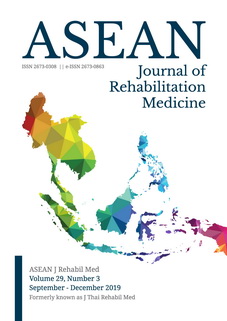The Effect of Paretic Side Quadriceps Resistive Exercise on Weight-Bearing Asymmetry in Standing Position and Lean Muscle Mass of Subacute Stroke Patients
Keywords:
stroke, quadriceps resistive exercise, lean muscle mass, weight bearing asymmetryAbstract
Objectives: To evaluate the efficacy of paretic side quadriceps resistive exercise on weight-bearing asymmetry and lean muscle mass of stroke patients.
Study design: Experimental clinical study.
Setting: Physical Medicine and Rehabilitation Department, Faculty of Medicine, Hasan Sadikin Hospital, Bandung.
Subjects: Patients with subacute stroke (2 weeks-6 months after the first stroke), aged 45-59 years old.
Methods: All subjects were given paretic side quadriceps resistive exercise with the intensity of 40% 1 RM, 25 repetitions per set, 3 sets per time, 3 times a week, for 8 weeks. Lean muscle mass and weight-bearing asymmetry were evaluated pre- and post- intervention .
Results: Twelve patients (8 males and 4 females) with mean age of 55.5 (SD 5.1) years were recruited. Lean muscle mass assessed with bioelectrical impedance analysis was 9.09 (SD 2.81) in pre- and 8.87 (2.73) in post- intervention whereas weight-bearing asymmetry was 9.52 (SD 5.63) in pre- and 5.98 (SD 5.445) in post- intervention. When comparing pre- and post- intervention outcomes, there was a significant difference in weight-bearing asymmetry (p = 0.034) but lean muscle mass did not significantly change (p = 0.146).
Conclusion: Quadriceps resistive exercise of paretic side was not effective in increasing lean muscle mass but it reduced weight-bearing asymmetry of subacute stroke patients. Therefore, a unilateral resistive exercise of a paretic side may be an effective intervention for stroke rehabilitation during subacute phase to improve weight-bearing symmetry.
References
2. Towfighi A, Saver JL. Stroke declines from third to fourth leading cause of death in the United States: historical perspective and challenges ahead. Stroke. 2011;42:2351-5.
3. Stein J, Brandstater ME. Stroke Rehabilitation. In: DeLisa JA, editor. Physical medicine and rehabilitation: principles and practice. Philadelphia: Lippincott Williams & Wilkins; 2005. p. 551–70
4. PB PERDOSRI. Panduan Pelayanan Klinis Rehabilitasi Medik. Jakarta: Perdosri; 2012.
5. Billinger SA, Arena R, Bernhardt J, Eng JJ, Franklin BA, Johnson CM, et al. Physical activity and exercise recommendations for stroke survivors. a statement for healthcare professionals from the American Heart Association/American Stroke Association. Stroke. 2014;45:2532–53.
6. Knop M, Werner CG, Scherbakov N, Fiebach J, Dreier JP, Meisel A, et al. Investigation of changes in body composition, metabolic profile and skeletal muscle functional capacity in ischemic stroke patients: the rationale and design of the Body Size in Stroke Study (BoSSS). J Cachexia Sarcopenia Muscle. 2013;4:199–207.
7. Jorgersen L, Jacobsen BK. Change in muscle mass, fat mass, and bone mineral content in the legs after stroke: a 1 year prospective study. Bone. 2001;28:655-9.
8. Scherbakov N, Doehner W. Sarcopenia in stroke-facts and numbers on muscle loss accounting for disability after stroke. J Cachexia Sarcopenia Muscle. 2011;2:5–8.
9. Yavuzer G, Eser F, Karakus D, Karaoglan B, Stam HJ. The effects of balance training on gait late after stroke: a randomized controlled trial. J Clin Rehabil. 2006;20:960–9.
10. Eriksrud O, Bohannon RW. Relationship of knee extension force to independence in sit-to-stand performance in patients receiving acute rehabilitation. Phys Ther. 2003;83:544–51.
11. Kisner C, Colby LA. Resistance exercise for impaired muscle performance. In: Kisner C, Colby LA. editors: Therapeutic exercise: foundations and techniques. 5th ed. Philadelphia: F.A. Davis; 2007. p. 157-9.
12. Dahlan MS. Sample size and sampling method. 3rd ed. Jakarta: Salemba Medik; 2013. p.145-57.
13. Sergi G, De Rui M, Stubbs B, Veronese N, Manzato E. Measure-ment of lean body mass using bioelectrical impedance analysis: a consideration of the pros and cons. Aging Clin Exp Res. 2017; 29:591-7.
14. Cooper C. Fundamentals of hand therapy: clinical reasoning and treatment guidelines for common diagnoses of the upper extremity. Missouri: Mosby Elsevier; 2007. p. 59-66.
15. Agresti A. An introduction to categorical data analysis. 2nd ed. New Jersey: John Wiley & Sons; 2007. p. 34-48.
16. Kraemer WJ, Spiering BA, Vescovi JD. Adaptability of skeletal muscle: responses to increased and decreased use. In: Magee DJ, editor. Pathology and intervention in musculoskeletal rehabilitation. 2nd ed. Missouri: Elsevier; 2016. p. 79-96.
17. Ryan AS, Dobrovolny CL, Smith GV, Silver KH, Macko RF. Hemiparetic muscle atrophy and increased intramuscular fat in stroke patients. Arch Phys Med Rehabil. 2002;83:1703-7.
18. Ryan AS, Ivey FM, Prior S, Li G, Macko CH. Skeletal muscle hypertrophy and muscle myostatin reduction after resistive training in stroke survivors. Stroke. 2011;42:416–20.
19. Figueroa A, Vicil F, Gonzales MAS, Wong A, Ormsbee MJ, Hooshmand S, et al. Effects of diet and/or low intensity resistance exercise training on arterial stiffness, adiposity, lean mass in obese postmenopausal women. Am J Hypertens. 2013;26:416-23.
20. Engelke K, Museyko O, Laredo JD. Quantitative analysis of skeletal muscle by computed tomography imaging-State of the art. J Orthop Translat. 2018;15:91-103.
21. Scafoglieri A,Clarys JP, Bauer JM, Verlaan S, Malderen LV, Vantieghem S, et al. Predicting appendicular lean and fat mass with bioelectrical impedance analysis in older adults with physical function decline-the PROVIDE study. J Clin Nutr. 2017;36:869-75.


